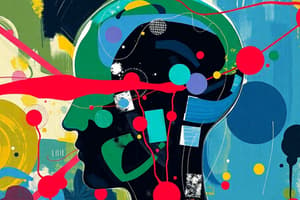Podcast
Questions and Answers
How would you differentiate between psychosis and schizophrenia?
How would you differentiate between psychosis and schizophrenia?
- Schizophrenia is a condition exclusively defined by disorganized thought, while psychosis includes disorganized behavior.
- Schizophrenia is a broad term encompassing various mental disorders, while psychosis is a specific condition characterized by hallucinations and delusions.
- Psychosis is a specific disorder with defined diagnostic criteria, whereas schizophrenia is a broader term describing a range of psychotic experiences.
- Psychosis is a broad term referring to a state of detachment from reality, with schizophrenia being a specific type of psychotic disorder. (correct)
What key contribution did Emil Kraepelin make to the understanding of schizophrenia?
What key contribution did Emil Kraepelin make to the understanding of schizophrenia?
- He discovered the link between schizophrenia and specific neurotransmitter imbalances in the brain.
- He identified the characteristic 'positive' and 'negative' symptoms of schizophrenia.
- He introduced the term 'schizophrenia' to replace the earlier term 'dementia praecox'.
- He differentiated 'dementia praecox' from manic-depressive illness and recognized subtypes of schizophrenia. (correct)
What is the significance of Eugen Bleuler's contribution to the understanding of schizophrenia?
What is the significance of Eugen Bleuler's contribution to the understanding of schizophrenia?
- He identified the genetic component of schizophrenia.
- He introduced the term 'schizophrenia' and described positive and negative symptoms. (correct)
- He developed the first antipsychotic medications to treat schizophrenia.
- He established the criteria for diagnosing schizoaffective disorder.
According to the DSM criteria, which condition must be ruled out to diagnose schizophrenia?
According to the DSM criteria, which condition must be ruled out to diagnose schizophrenia?
Which of the following best illustrates a persecutory delusion?
Which of the following best illustrates a persecutory delusion?
What is a key characteristic of auditory hallucinations that is often associated with schizophrenia?
What is a key characteristic of auditory hallucinations that is often associated with schizophrenia?
Which of the following negative symptoms of schizophrenia is characterized by a lack of initiation and persistence in activities?
Which of the following negative symptoms of schizophrenia is characterized by a lack of initiation and persistence in activities?
What is the term for the relative absence of speech, which can occur as a negative symptom of schizophrenia?
What is the term for the relative absence of speech, which can occur as a negative symptom of schizophrenia?
Which of the following best describes 'tangentiality' in the context of disorganized speech?
Which of the following best describes 'tangentiality' in the context of disorganized speech?
What is 'waxy flexibility' a symptom of, and how does it manifest?
What is 'waxy flexibility' a symptom of, and how does it manifest?
How does schizophreniform disorder differ from schizophrenia?
How does schizophreniform disorder differ from schizophrenia?
What is a key feature of schizoaffective disorder that distinguishes it from a mood disorder with psychotic features?
What is a key feature of schizoaffective disorder that distinguishes it from a mood disorder with psychotic features?
What is the primary characteristic of delusional disorder?
What is the primary characteristic of delusional disorder?
How does brief psychotic disorder typically resolve?
How does brief psychotic disorder typically resolve?
What is the key distinction between the 'process' and 'reactive' distinctions in relation to schizophrenia?
What is the key distinction between the 'process' and 'reactive' distinctions in relation to schizophrenia?
According to the Type I vs. Type II distinction in schizophrenia, what characteristics are associated with Type I?
According to the Type I vs. Type II distinction in schizophrenia, what characteristics are associated with Type I?
What is a key feature of paranoid schizophrenia that differentiates it from other subtypes?
What is a key feature of paranoid schizophrenia that differentiates it from other subtypes?
Which of the following is characteristic of disorganized schizophrenia (hebephrenic)?
Which of the following is characteristic of disorganized schizophrenia (hebephrenic)?
Echolalia and echopraxia are associated with which subtype of schizophrenia?
Echolalia and echopraxia are associated with which subtype of schizophrenia?
What is the primary characteristic of undifferentiated schizophrenia?
What is the primary characteristic of undifferentiated schizophrenia?
Which of the following is a common characteristic of residual schizophrenia?
Which of the following is a common characteristic of residual schizophrenia?
What is the approximate worldwide prevalence of schizophrenia?
What is the approximate worldwide prevalence of schizophrenia?
Which factor is associated with a better prognosis in schizophrenia?
Which factor is associated with a better prognosis in schizophrenia?
What is a common comorbidity associated with schizophrenia?
What is a common comorbidity associated with schizophrenia?
How does the risk for schizophrenia change with genetic relatedness?
How does the risk for schizophrenia change with genetic relatedness?
According to family studies, what is inherited in relation to schizophrenia?
According to family studies, what is inherited in relation to schizophrenia?
What percentage of risk for schizophrenia is observed in monozygotic twins?
What percentage of risk for schizophrenia is observed in monozygotic twins?
What is the core concept behind the dopamine hypothesis of schizophrenia?
What is the core concept behind the dopamine hypothesis of schizophrenia?
What is a common side effect of dopamine antagonist medications used to treat schizophrenia?
What is a common side effect of dopamine antagonist medications used to treat schizophrenia?
Which brain abnormality has been consistently observed in schizophrenia research?
Which brain abnormality has been consistently observed in schizophrenia research?
What prenatal factor has been associated with an increased risk of schizophrenia in offspring?
What prenatal factor has been associated with an increased risk of schizophrenia in offspring?
Which cognitive function is commonly impaired in individuals with schizophrenia?
Which cognitive function is commonly impaired in individuals with schizophrenia?
What role does stress play in the development or course of schizophrenia?
What role does stress play in the development or course of schizophrenia?
What is 'expressed emotion' (EE) in the context of family interactions and schizophrenia?
What is 'expressed emotion' (EE) in the context of family interactions and schizophrenia?
What is the primary effect of antipsychotic (neuroleptic) medications in treating schizophrenia?
What is the primary effect of antipsychotic (neuroleptic) medications in treating schizophrenia?
What is tardive dyskinesia, and which type of medication is it associated with?
What is tardive dyskinesia, and which type of medication is it associated with?
What is a significant advantage of atypical antipsychotics compared to typical antipsychotics?
What is a significant advantage of atypical antipsychotics compared to typical antipsychotics?
Which psychosocial approach involves responses being met with reinforcement or punishment to shape behavior?
Which psychosocial approach involves responses being met with reinforcement or punishment to shape behavior?
What is the primary goal of behavioral family therapy in the treatment of schizophrenia?
What is the primary goal of behavioral family therapy in the treatment of schizophrenia?
Flashcards
Psychosis
Psychosis
A broad term referring to conditions involving hallucinations or delusions.
Schizophrenia
Schizophrenia
A specific type of psychosis characterized by disturbed thought, emotion, and behavior.
Delusions
Delusions
Erroneous beliefs that involve a misinterpretation of perceptions or experiences.
Hallucinations
Hallucinations
Signup and view all the flashcards
Avolition (Apathy)
Avolition (Apathy)
Signup and view all the flashcards
Alogia
Alogia
Signup and view all the flashcards
Anhedonia
Anhedonia
Signup and view all the flashcards
Asociality
Asociality
Signup and view all the flashcards
Affective Flattening
Affective Flattening
Signup and view all the flashcards
Tangentiality
Tangentiality
Signup and view all the flashcards
Loose Associations
Loose Associations
Signup and view all the flashcards
Inappropriate Affect
Inappropriate Affect
Signup and view all the flashcards
Catatonia
Catatonia
Signup and view all the flashcards
Schizophreniform Disorder
Schizophreniform Disorder
Signup and view all the flashcards
Schizoaffective Disorder
Schizoaffective Disorder
Signup and view all the flashcards
Delusional Disorder
Delusional Disorder
Signup and view all the flashcards
Brief Psychotic Disorder
Brief Psychotic Disorder
Signup and view all the flashcards
Schizotypal Personality Disorder
Schizotypal Personality Disorder
Signup and view all the flashcards
Genetic Risk for Schizophrenia
Genetic Risk for Schizophrenia
Signup and view all the flashcards
Dopamine Hypothesis
Dopamine Hypothesis
Signup and view all the flashcards
Structural Brain Abnormalities in Schizophrenia
Structural Brain Abnormalities in Schizophrenia
Signup and view all the flashcards
Expressed Emotion (EE)
Expressed Emotion (EE)
Signup and view all the flashcards
Antipsychotic (Neuroleptic) Medications
Antipsychotic (Neuroleptic) Medications
Signup and view all the flashcards
Extrapyramidal Side Effects (EPS)
Extrapyramidal Side Effects (EPS)
Signup and view all the flashcards
Tardive Dyskinesia
Tardive Dyskinesia
Signup and view all the flashcards
Study Notes
- Psychosis is a broad term for conditions involving hallucinations and delusions, while schizophrenia is a specific type of psychosis. Both are heterogeneous.
- There are various causes and types of psychosis and schizophrenia, characterized by disturbances in thought, emotion, and behavior.
Historical Background
- Emil Kraepelin used the term "dementia praecox" (premature dementia) and focused on subtypes of schizophrenia while recognizing it as a brain disease, distinguishing it from manic-depressive illness.
- Eugen Bleuler introduced "schizophrenia," meaning "splitting of the mind," highlighting the inability to maintain a consistent train of thought. He described "positive" and "negative" symptoms.
DSM-IV Criteria for Schizophrenia
- Requires two or more of the following symptoms for a significant portion of a 1-month period (or less if successfully treated):
- Delusions
- Hallucinations
- Disorganized speech (frequent derailment or incoherence)
- Grossly disorganized or catatonic behavior
- Negative symptoms (affective flattening, alogia, avolition)
- Social/occupational dysfunction
- Continuous signs of disturbance for at least 6 months
- Symptoms cannot be due to schizoaffective or mood disorder, or substance abuse.
Positive Symptom Cluster
- Involves active and obvious manifestations of abnormal behavior
- Represents an excess or distortion of normal behavior.
- Delusions are erroneous beliefs, often misinterpretations of perceptions or experiences held very strongly.
- Types of delusions:
- Persecutory (most common): belief of being persecuted.
- Referential: belief that gestures or comments are directed at oneself.
- Erotomania: belief that someone is in love with the individual.
- Somatic: delusions about bodily functions or sensations.
- Nihilistic: belief in the nonexistence of things.
- Grandiose: belief of inflated worth, power, knowledge, identity, or relationship to a deity or famous person.
- Bizarre: delusions that are implausible and not understandable to peers.
- Hallucinations are sensory experiences without environmental input, occurring in any sensory mode (auditory, visual, olfactory, gustatory, tactile).
- Auditory hallucinations are most common, often in the form of "voices" distinct from one's thoughts; scary forms may include "command" hallucinations.
- Having two or more voices conversing or one voice providing running commentary is highly characteristic of schizophrenia.
- Delusions and hallucinations often share congruent themes.
- Imaging studies show subtle structural damage in brain areas associated with auditory processing, such as a thinner cortex, and fMRI studies show activation of auditory regions during auditory hallucinations.
Negative Symptom Cluster
- Reflects the absence or insufficiency of normal behavior:
- Avolition (apathy): lack of initiation and persistence in activities.
- Alogia: relative absence of speech, possibly due to decreased thought production.
- Anhedonia: lack of pleasure or indifference.
- Asociality: limited interest in social interactions.
- Affective flattening: little expressed emotion; immobile and unresponsive face; may not indicate experienced emotion and may appear before other symptoms.
Disorganized Symptom Cluster
- Involves severe and excess disruptions in:
- Speech (tangentiality, loose associations, word salad, neologisms).
- Affect (inappropriate emotional behavior inconsistent with context).
- Behavior (disheveled appearance, odd conduct, unpredictable actions).
- Catatonia includes wild agitation, waxy flexibility, and immobility.
Other Disorders With Psychotic Features
- Schizophreniform Disorder: schizophrenic symptoms lasting 1-6 months (impaired functioning not required).
- Schizoaffective Disorder: symptoms of both schizophrenia and a mood disorder, with delusions and/or hallucinations present for at least 2 weeks without mood disorder symptoms.
- Bipolar Type: if mania is part of the presentation
- Depressive type: if only major depressive episodes are part of the presentation
- Delusional Disorder: one or more delusions persisting for 1 month or more, lacking other positive and negative symptoms.
- Brief Psychotic Disorder: one or more positive schizophrenia symptoms lasting 1 day to 1 month, often triggered by extreme stress or trauma, and tends to remit on its own.
- Schizotypal Personality Disorder: a less severe form of schizophrenia.
Classification Systems and Schizophrenia
- Process vs. Reactive Distinction: process schizophrenia has an insidious onset, biological basis, negative symptoms, and poor prognosis; reactive schizophrenia has an acute onset (extreme stress), notable behavioral activity, and better prognosis.
- Good vs. Poor Premorbid Functioning: focuses on functioning before developing schizophrenia.
- Type I vs. Type II Distinction:
- Type I: positive symptoms, good response to medication, optimistic prognosis, and absence of intellectual impairment.
- Type II: negative symptoms, poor response to medication, pessimistic prognosis, and intellectual impairments.
Defunct Subtypes of Schizophrenia
- Paranoid Type: prominent hallucinations and delusions (usually persecution or grandeur) with relatively intact cognitive skills and affect, organized around a coherent theme.
- Disorganized Type: marked disruptions in speech and behavior with flat or inappropriate affect.
- Catatonic Type: unusual motor responses and odd mannerisms like immobility, excessive motor activity, motor negativism, or waxy flexibility.
- Undifferentiated Type: major schizophrenia symptoms that fail to meet criteria for another type.
- Residual Type: past diagnosis of schizophrenia with an absence of prominent delusions, hallucinations, disorganized speech, and behavior, but continued display of less extreme residual symptoms (negative or attenuated positive symptoms).
Facts and Statistics About Schizophrenia
- Worldwide prevalence is about 0.3-0.7%.
- Onset typically occurs in early adulthood: early to mid-20s for men, late 20s for women, with a bimodal distribution for women.
- Better prognosis indicators: good premorbid adjustment, acute onset, later age of onset, being female, precipitating events, immediate treatment, treatment compliance, family history of mood problems vs. schizophrenia, and good interepisode functioning.
- 5-6% die by suicide; 20% attempt suicide.
- The disorder is generally chronic, with 20% doing well, and many suffer moderate-to-severe lifetime impairment.
- Life expectancy is slightly less than average.
- It affects males and females about equally, with a slightly higher prevalence in men.
- Females tend to have a better long-term prognosis.
- High comorbidity with tobacco use disorder and anxiety disorders.
- Common cognitive deficits, especially in working memory, contribute to significant functional impairment.
Causes of Schizophrenia: Genetic Research
- Strong genetic component:
- Family studies show increased risk with greater genetic relatedness but do not inherit specific forms of schizophrenia.
- Twin studies show monozygotic twins have a 48% risk, while dizygotic twins have a 17% risk.
- Adoption studies indicate risk remains high when a biological parent has schizophrenia.
- Significant overlap in genes contributing to schizophrenia, schizoaffective disorder, and manic syndromes.
- The risk for schizophrenia increases with genetic relatedness and is transmitted independently of diagnosis.
Causes of Schizophrenia: Neurotransmitter Influences
- The Dopamine Hypothesis suggests that drugs increasing dopamine (agonists) result in schizophrenic-like behavior, while drugs decreasing dopamine (antagonists) reduce such behavior.
- Current theories emphasize multiple neurotransmitters, with possibilities the higher density of dopamine receptors and the excessive stimulation of dopamine D2 receptors in the striatum (positive symptoms) and deficient stimulation of prefrontal dopamine D1 receptors (negative symptoms).
Structural and Functional Abnormalities in the Brain
- Enlarged lateral ventricles are found in some but not all schizophrenics.
- Less active frontal and temporal lobes.
- Less frontal, temporal, and whole-brain volume (particularly in the hippocampus).
- Brain dysfunction appears before onset.
- Viral infections during prenatal development and birth complications associated with hypoxia may be factors.
- Substantial cognitive dysfunctions are linked to functional impairment.
- No abnormality is specific to schizophrenia or characterizes all patients.
- Abnormalities in neural density, structure, and interconnections, with no signs of postnatal injury.
Causes of Schizophrenia: Psychological and Social Influences
- Stress may activate underlying vulnerability and increase relapse risk.
- Family Interactions: high expressed emotion (critical, hostile, or emotionally over-involved family members) is associated with relapse.
Medical Treatment of Schizophrenia
- Antipsychotic (neuroleptic) medications are usually the first line of treatment, reducing or eliminating positive symptoms.
- Compliance with medication is often a problem.
- Common side effects include:
- Extrapyramidal Side Effects (Parkinsonian symptoms, Akathisia, Dystonia).
- Tardive dyskinesia (involuntary movements of the tongue, face, mouth, and jaw), which is usually irreversible.
- Atypical antipsychotics have fewer EPS but more weight gain and some can cause life-threatening problems like Agranulocytosis.
- New methods for reducing noncompliance include injections and psychosocial interventions.
Psychosocial Treatment of Schizophrenia
- Behavioral techniques (token economies, operant conditioning).
- Community care programs.
- Social and living skills training.
- Behavioral family therapy (reduce EE and increase supportiveness).
- Vocational rehabilitation.
- Psychosocial approaches are a necessary part of medication therapy.
Studying That Suits You
Use AI to generate personalized quizzes and flashcards to suit your learning preferences.




